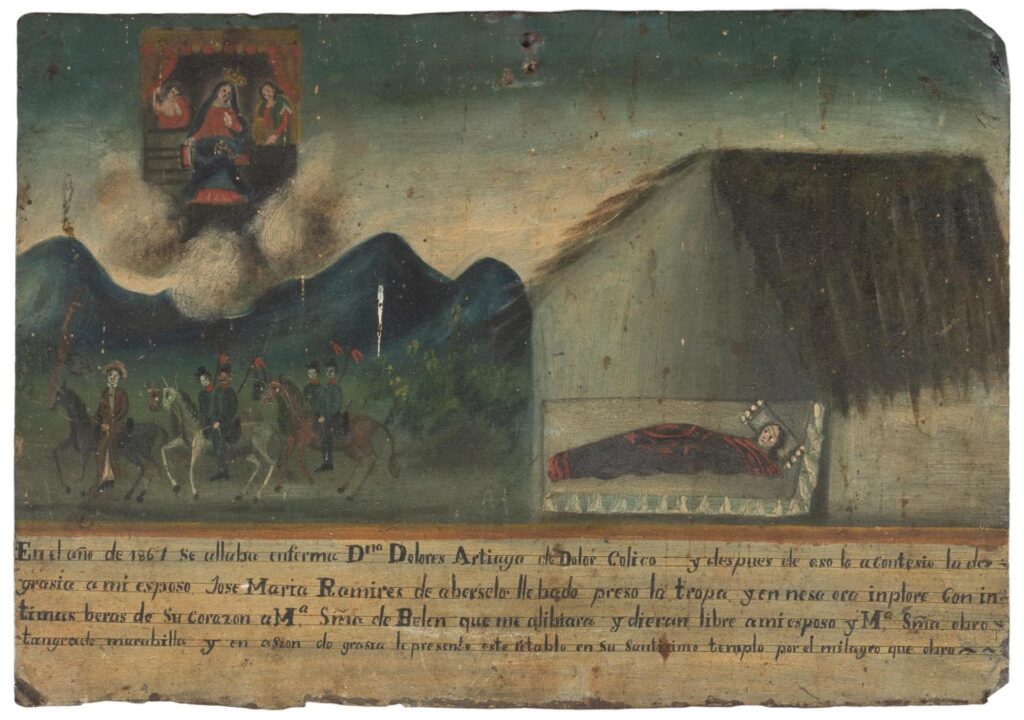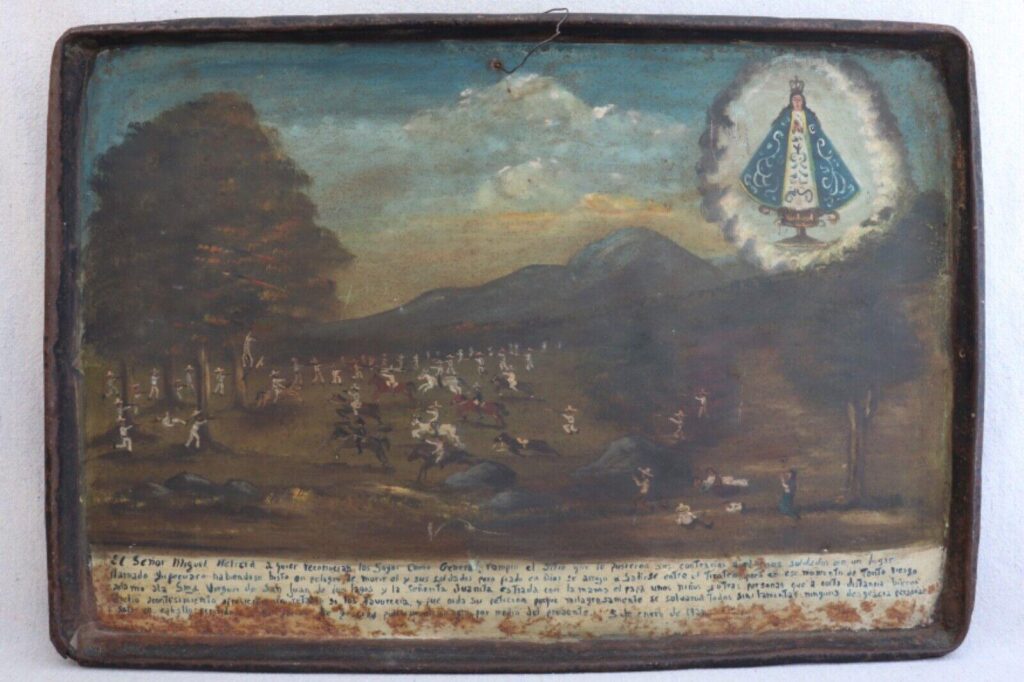#Art #Gratitude #ExVotos #Give #Heartfelt #WorthPoint

I recently came across a contemporary painting and was intrigued by its kookiness: Two curious ice cream cone-shaped aliens reach for an ice cream cone from a vendor. The text gives thanks that everything went well, presumably because the vendor wasn’t abducted.
The painting, by Mexican artist Miguel Hernandez, is known as an “ex-voto” or retablo. These charming artworks are collected for their heartfelt (and sometimes lighthearted and bizarre) expressions of gratitude.
GIVING THANKS
Many people turn to a higher power and pray for divine intervention when misfortune or tragedy strikes. Ex-votos (Latin for “from a vow”) are devotional offerings made to holy figures in thanks for answering these prayers and granting miracles.
The tradition of offering ex-votos has existed since ancient times and in many forms, including Sacred Hearts, sculpted body parts, crutches, plaques, and war medals. People typically left these votive offerings at local churches and shrines as public testimonies of their faith and gratitude for receiving a miracle.
VISUAL STORYTELLING
The most common and significant ex-votos are the small narrative paintings. These are some of the best examples of folk art today and offer a peek into the everyday life of ordinary people. Whether granted healing from an illness or injury, an escape from harm, protection from fires and plagues, or surviving a shipwreck, people have used ex-votos and retablos to express their gratitude to divine intervention for near misses and good luck.
Painted ex-votos originated in 15th-century Italy and reached Mexico a century later through Spanish colonizers spreading Catholicism. Mexicans adopted this imaginative way to thank Our Lady of Guadalupe, saints, and other Catholic holy figures for their help and commissioned local artists to paint them.
Ex-votos became especially popular after Mexico’s successful battle for independence from Spain in the early 1800s. The Mexican Revolutionary War in the early 1900s also revived interest.
The paintings, typically made on tin, depict the moment a miracle happened, the divine figure who granted it, and a brief narrative. Throughout the centuries, they have dramatically, poignantly, and humorously illustrated such things as animal attacks, automobile accidents, falling flower pots, gun accidents, injustices to the working class, a brutal mastectomy in 1777, natural disasters, protection from ghosts and skeletons, banishing inner demons, and violent crime scenes. Each painting features the spiritual entity appearing to save the day like a holy superhero.
Ex-votos are records of historic diseases and treatments, many of which the U.S. National Library of Medicine exhibits online.
By the 20th century, contemporary artists were inspired by this dramatic folk art, including prominent Mexican painters Frida Kahlo and her husband, Diego Rivera, who avidly collected hundreds. Many came from churches and are on view in the Frida Kahlo Museum in Mexico City. It’s believed that this 1934 ex-voto of a woman who survived a stabbing, thanks to the Blessed Virgin Talpa miraculously saving her life, inspired Kahlo’s A Few Small Nips from 1935.

KEEPING THE TRADITION ALIVE
Although ex-voto paintings have a historical origin, some artists still maintain the tradition.
Collector Mariolina Rizzi Salvatori says that in Mexico, the ex-voto tradition is being re-appropriated and transformed in various ways, including commercially produced as souvenirs and decorative objects. Women in small rural communities also embroider and sell them to support their families.
According to Salvatori, some argue that collecting ex-votos, exhibiting them at museums, and writing scholarly articles about them is a form of appropriation. However, she says this argument fails to recognize that these collections and museum exhibits can also ignite responsible and respectful appreciation of these cultural artifacts and expressions that would otherwise remain marginal or be ignored.
The paintings have become popular with collectors in the past few years, and the COVID-19 pandemic particularly rekindled interest when artists started creating them in thanks for the recovery of loved ones and to those who helped during the crisis.

COLLECTING EX-VOTOS
Collectors seek Sacred Heart ex-votos, though antique ones are harder to find and greatly vary, depending on the size, inscription, material, and if they’re jeweled. Examples range from copper and silver to encased and embroidered. While some antique hearts can cost upward of a thousand, replicas at eBay, Etsy, and other marketplaces are more affordable, and some are a few dollars.
There are also ex-voto plaques and sculptures in the shapes of body parts that symbolize a miraculously healed arm, ear, or foot. Antique examples can cost hundreds, while replicas are $10 to $50.
Antique ex-voto paintings can also be hard to find; some fetch thousands of dollars. Nearly all authentic antique ex-votos and retablos include divine figures and text written in the originating country’s language. Mexican retablos tend to have more narrative text. Because these paintings hung in churches and homes for years, antique and vintage examples can have faded colors compared to contemporary images that are bold and vivid. Antique paintings also tend to depict more serious topics, while contemporary retablos cover a vast range of humorous and modern issues.
Highly collectible contemporary ex-voto artists include Miguel Hernandez, Rafael Rodriguez Contreras, Alfredo Vilchis Roque, and Nicario Jiménez Quispe (who creates retablos in the Peruvian tradition with painted figurines and wooden cases). Contemporary paintings by noted artists commonly range from $50 to $500. Contemporary retablos by unknown artists are typically $50 and under.
While some events depicted in these paintings likely didn’t happen—are there really ice cream cone aliens visiting Earth to buy ice cream cones?—they are still delightful. Ex-votos are also great reminders of the importance of expressing gratitude, even if it’s in an unusual way.
Adina K. Francis has been a writer and editor in the antiques and collectibles field for more than 20 years. She has a bit of an obsession with the Victorians and thinks that dogs are one of life’s greatest gifts.
WorthPoint—Discover. Value. Preserve.




